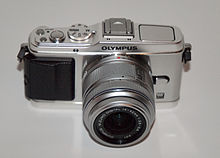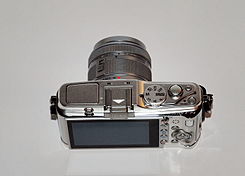- Olympus PEN E-P3
-
Olympus Pen E-P3 Type Micro Four Thirds, interchangeable lens camera Sensor Four Thirds System 18.00 × 13.50 mm ( 17.30 × 13.00 mm imaging area) Live MOS Maximum resolution 4032×3024 (12.3 megapixels) Lens Micro Four Thirds System mount Flash Built-in pop up, TTL, GN 10.5m equivalent (ISO100 · m); hotshoe for external flash attachment Shutter 1/4,000 to 60 s, 30 minutes bulb Exposure metering Digital ESP metering, Centre weighted average metering, Spot metering Exposure modes Program, shutter-priority, aperture-priority, manual Metering modes TTL ESP multi patterned (324-area multi pattern metering), Center-weighted average, Spot (1%) Focus areas 11 area contrast detect auto-focus, selectable Focus modes Single, continuous, manual Continuous shooting 3 frame/s Viewfinder live preview, optional electronic viewfinder VF-2; optional electronic viewfinder VF-3; optional optical viewfinder VF-1 ASA/ISO range ISO 200–12800 Rear LCD monitor 3" 614K dots OLED LCD on screen with live preview with capacitive touchscreen control Storage Secure Digital card; SDHC; SDXC Battery Olympus BLS-1 or BLS-5 Lithium-ion battery Dimensions 122 × 69.1 × 34.3 mm (4.8" × 2.72" × 1.35") Weight 321 g (11.3 oz) (body only) 369 g (13.0 oz) (body, battery and SD memory card) Footnotes Optional, exchangeable grips are available for right side of body The Olympus PEN E-P3 announced on June 30, 2011 [1] is Olympus Corporation's seventh camera that adheres to the Micro Four Thirds (MFT) system design standard. The E-P3 succeeds the Olympus PEN E-P2, and was announced in concert with two other models, the Olympus PEN E-PL3 (Lite version of E-P3), and the Olympus PEN E-PM1 (a new "Mini" version of the PEN camera line with similar features to the E-PL3).
The EP-3 addresses some of the concerns that critics had about previous PEN models, notably, slow handling, due to slow autofocus speed and difficulty seeing the LCD panel under certain (e.g., bright, sunny) conditions.
The E-P3 increases autofocus speed through use of a 120 Hz refresh rate for its sensor, similar to the technology used in the recently released Panasonic Lumix DMC-GH2 and G3 cameras. Olympus claims, based on in-house testing, that the E-P3 has the world's fastest autofocus speed of any camera as of the product announcement date.[2] The benefits of the 120 Hz refresh rate also provides the ability for continuous autofocus tracking during bursts of exposures, a faster shutter response (less lag) and less blackout time between exposures.
The E-P3 now uses a capacitive touchscreen for creative camera control, and a new OLED type display that is suppposed to vastly improve performance in sunny conditions, and off-angle viewing. The EP-3 continues with the proprietary Accessory Port, a power and communication port, which allows the use of various accessories, such as an external stereo microphone for HD video recording, LED macro lights, and a bluetooth communications adapter. The accessory port continues to be compatible with the high resolution, optional hotshoe mounted VF-2 electronic viewfinder (EVF). The VF-2 had a flip angle eyepiece, allowing viewing from 0–90 degrees. The VF-2 had been criticized for being very expensive and for not having a locking device, with some users reporting easy dislodgement of the VF-2 from the hotshoe. To address these criticisms, in July 2011, Olympus announced the introduction of an optional VF-3 EVF, which has a lower resolution, a locking device, and probably most importantly a USD$100 lower MSRP.
In the United States the E-P3 MSRP with new 14–42 mm kit zoom lens or 17 mm f/2.8 pancake lens was USD 899. The accessory VF-3 EVF was also available separately for USD 180.00. Available body colors were black and silver.
Contents
About the Micro Four Thirds System
The Micro Four Thirds (MFT) system design standard was jointly announced in 2008[3] by Olympus and Panasonic, as a further evolution of the similarly named predecessor Four Thirds System system [4] pioneered by Olympus. The Micro Four Thirds system standard uses the same sized sensor (nominal 4000 pixels by 3000 pixels) as the original Four Thirds system. One potential advantage of the smaller MFT system sensor (when compared to market leaders Canon and Nikon APS-C and full frame sized) are smaller and lighter lenses. The smaller MFT sensor allows for a reduced image circle which allows the development of smaller and lighter native lenses. The MFT sensor has a crop factor of 2.0 when compared to 35mm film equivalent full frame sensors. By comparison, the more popular consumer (as opposed to professional) DSLRs such as those made by [[Canon_(company)#Digital_cameras|]], Nikon and Sony have 1.5 to 1.6 crop factor APS-C sensors, which means larger and heavier lens designs. For example, a typical Olympus MFT M.Zuiko 14-42mm f/3.5-5.6 kit lens weighs 112 grams (4.0 oz), is 56 millimetres (2.2 in) in diameter and 50 millimetres (2.0 in) in length.[5] The equivalent Canon APS-C DSLR EF-S 18-55mm f3.5-5.6 kit lens weighs 190g, and is 69mm in diameter and 80mm in length[6]
While the older Four Thirds system design standard allowed the incorporation of a single lens reflex (SLR) camera design including a mirror box and pentaprism based optical viewfinder system, the MFT system design standard sought to pursue a technically different camera, and specifically slimmed down the key physical specifications which eliminated the ability to include the traditional complex optical path and the bulky mirror box needed for a SLR optical viewfinder. Instead, MFT uses either a built-in (Panasonic) or optional (Olympus/Panasonic) compact electronic viewfinder (EVF) and/or LCD back panel displaying a Live view from the main image sensor. Use of an EVF/back panel LCD and smaller four thirds image sensor format and allows for smaller and lighter camera bodies and lenses. The MFT system standard also specifically includes seamless switching between still photography and HD video recording recording as a design criterion.
MFT cameras are physically slimmer than most interchangeable lens cameras because the standard specifies a much reduced lens mount flange to imaging sensor plane distance of just 20 millimetres (0.79 in). Typically this so called flange focal distance is over 40 millimetres (1.6 in) on most interchangeable lens cameras.[7] The MFT system design flange focal length distance allows for, through use of an adapter, the possibility to mount virtually any manufacturer's existing and legacy still camera interchangeable lens (as well as some video and cine lenses) to an MFT body, albeit using manual focus and manual aperture control. For example, many theoretically obsolete 35mm film camera lenses, as well as existing current lenses for APS-C and full frame DSLR's are now usable on MFT cameras. As an example, an older (i.e., used, obsolete and low priced), but still high quality, 50mm f/1.8 "standard" lens from a 35mm film camera can be used on a MFT camera body. With MFT sensors having a crop factor of 2.0, the old 50mm f/1.8 "standard" lens becomes a high-speed (although manual) 100mm f/1.8 telephoto portrait lens. So the MFT system allows the re-use of expensive lenses that may have outlived their 35mm film format camera, and can be used on a modern digital camera body capable of both still and HD video recording. Similarly, the MFT system design allows current DSLR lenses to be used as well, although only with manual focus and aperture control.
Differences over Olympus PEN E-P1
- Addition of an Accessory Port that can be used for an electronic viewfinder or external microphone
- Two new Art filters-simulating Diorama and Cross process in camera
- Black finish widely available, silver finish available in Japan
- Auto focus tracking
- Colour boosting function named i-Enhance
Specifications not in the infobox
See also
Micro Four Thirds Camera Introduction Roadmap
Item Model Sensor Electronic View Finder (EVF) Announced 1 Panasonic Lumix DMC-G1 4:3 / 13.1 mp (12.1 mp effective) EVF; 1.4x magnification; 1.44K dots 2008, October [9] 2 Panasonic Lumix DMC-GH1 4:3; 3:2; 16:9 (multi-aspect); 14.0 mp (12.1 mp effect) EVF; 1.4x mag; 1.44K dots 2009, April [10] 3 Olympus PEN E-P1 4:3 / 13.1 mp (12.3 mp effect) optional hotshoe optical VF-1; 65 degree AOV 2009, July [11] 4 Panasonic Lumix DMC-GF1 4:3 / 13.1 mp (12.1 mp effect) opt hotshoe EVF LVF1; 1.04x mag; 202K dots 2009, September [12] 5 Olympus PEN E-P2 4:3 / 13.1 mp (12.3 mp effect) opt hotshoe EVF VF-2; 1.15x mag; 1.44K dots 2009, November [13] 6 Olympus PEN E-PL1 4:3 / 13.1 mp (12.3 mp effect) opt hotshoe EVF VF-2; 1.15x mag; 1.44K dots 2010, February [14] 7 Panasonic Lumix DMC-G10 4:3 / 13.1 mp (12.1 mp effect) EVF; 1.04x magnification; 202K dots 2010, March [15] 8 Panasonic Lumix DMC-G2 4:3 / 13.1 mp (12.1 mp effect) EVF; 1.4x mag; 1.44K dots 2010, March [16] 9 Panasonic Lumix DMC-GH2 4:3; 3:2; 16:9 (multi-aspect); 18.3 mp (16.0 mp effect) EVF; 1.42x mag; 1.53K dots 2010, September [17] 10 Panasonic Lumix DMC-GF2 4:3 / 13.1 mp (12.1 mp effect) opt hotshoe EVF; 1.04x mag; 202K dots 2010, November [18] 11 Olympus PEN E-PL1s 4:3 / 13.1 mp (12.3 mp effect) opt hotshoe EVF VF-2; 1.15x mag; 1.44K dots 2010, November [19] 12 Olympus PEN E-PL2 4:3 / 13.1 mp (12.3 mp effect) opt hotshoe EVF VF-2; 1.15x mag; 1.44K dots 2011, January [20] 13 Panasonic Lumix DMC-G3 4:3 / 16.6 mp (15.8 mp effect) EVF; 1.4x mag; 1.44K dots 2011, May [21] 14 Panasonic Lumix DMC-GF3 4:3 / 13.1 mp (12.1 mp effect) N/A 2011, June [22] 15 Olympus PEN E-P3 4:3 / 13.1 mp (12.3 mp effect) opt hotshoe EVF VF-2; 1.15x mag; 1.44K dots 2011, June[2] 16 Olympus PEN E-PL3 4:3 / 13.1 mp (12.3 mp effect) opt hotshoe EVF VF-2; 1.15x mag; 1.44K dots 2011, June[23] 17 Olympus PEN E-PM1 4:3 / 13.1 mp (12.3 mp effect) opt hotshoe EVF VF-2; 1.15x mag; 1.44K dots 2011, June[24] References
- ^ http://www.dpreview.com/news/1106/11063015olympusEP3preview.asp
- ^ a b http://www.olympus-global.com/en/news/2011a/nr110630ep3e.html
- ^ http://www.dpreview.com/news/0808/08080501microfourthirds.asp
- ^ http://www.four-thirds.org/en/fourthirds/whitepaper.html
- ^ http://www.four-thirds.org/en/microft/standard.html#i_014-042mm_f035-056_ii_olympus
- ^ http://www.dpreview.com/products/canon/lenses/canon_18-55_3p5-5p6_ii
- ^ http://en.wikipedia.org/wiki/Flange_focal_distance
- ^ http://www.olympusamerica.com/cpg_section/product.asp?product=1482&page=specs
- ^ http://www2.panasonic.com/webapp/wcs/stores/servlet/prModelDetail?storeId=11301&catalogId=13251&itemId=292233
- ^ http://panasonic.net/avc/lumix/popup/pressrelease/gh1.html#1
- ^ http://www.dpreview.com/news/0906/09061601olympusep1.asp
- ^ http://panasonic.net/avc/lumix/popup/pressrelease/dmc_gf1.html#1
- ^ http://www.dpreview.com/news/0911/09110501olympusep2.asp
- ^ "Olympus unveils the affordable Pen". Digital Photography Review. 2010-02-03. http://www.dpreview.com/news/1002/10020305olypenepl1.asp. Retrieved 2010-02-03.
- ^ http://panasonic.net/avc/lumix/popup/pressrelease/g2g10.html#2
- ^ http://panasonic.net/avc/lumix/popup/pressrelease/g2g10.html#1
- ^ http://panasonic.net/avc/lumix/popup/pressrelease/gh2.html
- ^ http://panasonic.net/avc/lumix/popup/pressrelease/gf2.html
- ^ http://olympus-imaging.jp/product/dslr/epl1s/index.html
- ^ http://www.dpreview.com/news/1101/11010622olympusepl2.asp
- ^ http://panasonic.net/avc/lumix/popup/pressrelease/g3.html
- ^ http://panasonic.net/avc/lumix/popup/pressrelease/gf3.html
- ^ http://www.olympus-global.com/en/news/2011a/nr110630epl3e.html
- ^ http://www.olympus-global.com/en/news/2011a/nr110630epm1e.html
External links
 Media related to Olympus E-P3 at Wikimedia Commons
Media related to Olympus E-P3 at Wikimedia Commons- Olympus PEN E-P3 Product Site
- Olympus PEN E-P3 Press Release
- Olympus PEN E-P3 Review - dpreview.com
- Olympus PEN E-P3 Overview - imaging-resource.com
Preceded by
Olympus PEN EP-1Olympus PEN Micro Four Thirds System cameras
November 2008–presentSucceeded by
Olympus PEN EP-3Categories:- Olympus cameras
- Live-preview digital cameras
- Micro Four Thirds system
Wikimedia Foundation. 2010.


